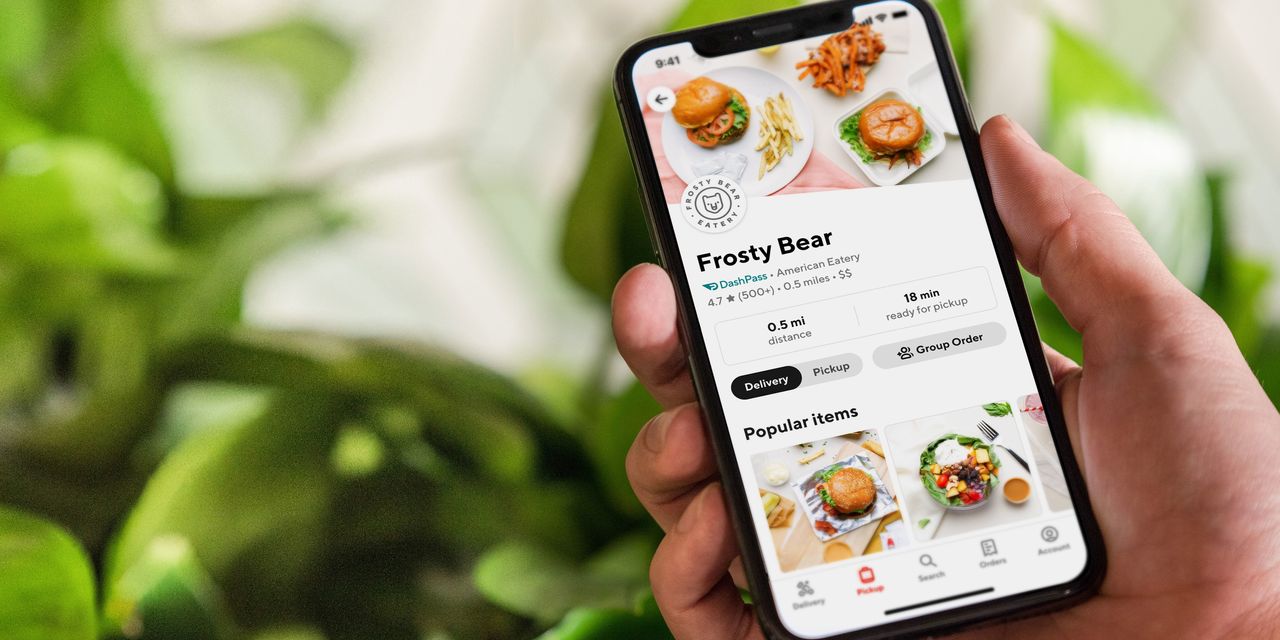

DoorDash Inc.
has started selling restaurant ads that appear atop the search results in its app, as companies in the largely unprofitable food-delivery industry dive deeper into advertising to boost revenue.
The company already let marketers pay to run ads offering free delivery or discounts, as well as banner ads, but hadn’t offered ads above its search results before it began testing the tool earlier this year.
DoorDash has also built an ad platform that lets restaurants purchase the placements via a bidding system without the help of an ad-sales person. The restaurants pay for sponsored listings only if users click through the ads and make orders. The self-serve system is designed to help local restaurants boost their brands, DoorDash said.
“Any mom-and-pop shop can go in, set a budget, and we only collect dollars if they get a transaction,” said
Toby Espinosa,
vice president for DoorDash Ads. Buyers can choose to direct their sponsored listings to new customers, existing customers or all customers, but DoorDash hopes to expand targeting categories to include other groups of users, such as frequent burger buyers.
In addition to the new services for restaurants, DoorDash is launching “featured listings” for consumer packaged goods brands to boost their placement within the convenience and grocery categories.
The move comes as an increasing number of consumer-facing businesses, including
Walmart Inc.
and
CVS Health Corp.
, have been offering advertisers more ways to reach consumers using retailer data.
DoorDash, founded eight years ago, generated a profit in the second quarter of 2020 as demand for home delivery surged early in the Covid-19 pandemic, according to paperwork filed for its initial public offering last year, but it has never turned an annual profit. It reported a net loss of $102 million in the three months ending June 30. The company says it has more than 450,000 merchants selling via its platform.
But DoorDash is wary of turning off consumers in the competitive food-delivery business by shoveling too many ads into its app. For restaurants, it will display only one sponsored listing on top of search results or in cuisine-specific sections of the app. For other areas, like the grocery, convenience, pet or alcohol categories, it will allow two ads.
“We cannot mess with the consumer experience. You will never see us going way overboard,” Mr. Espinosa said. “We have built an ad platform that’s trying to align incentives between the advertiser, the consumer and DoorDash.”
DoorDash declined to disclose how much of its revenue comes from ad sales or how much revenue it hopes to generate from the new ad products. The company said its goal for its advertising services is to boost its merchants’ success, not just its own profitability. “We feel this aligns us with our merchant partners, which creates the best long-term outcome for everyone,” a DoorDash spokeswoman said.
DoorDash holds more than half of U.S. market share for delivery apps, ahead of competitors including Grubhub Inc. and
Uber Technologies Inc.’s
Uber Eats and Postmates, according to Bloomberg Second Measure, a consumer data analytics company.
But each company is increasingly vying not only for consumers but advertisers.
Uber, which has a growing ads business, last year introduced sponsored listings in its Uber Eats app in the U.S. with a pay-per-click model that charges merchants each time a consumer clicks on the ad, even if they don’t make a purchase. Grubhub runs a marketplace that lets restaurants secure better placement in search results and provides other marketing help on a commission-based system. That company’s chief executive said earlier this year that advertising is the key to the company’s future profitability.
Nicole Milnthorpe,
chief financial officer at Florida-based casual dining chain Smokey Bones, said her company works with many of the outside delivery companies but its primary partners are Uber Eats and DoorDash. With 60 full-service Smokey Bones restaurants in the U.S., two ghost kitchens and two delivery-only chains, she said different types of advertising tools give the chains flexibility.
“Different markets respond differently to different types of marketing,” Ms. Milnthorpe said.
Smokey Bones ran an ad test on the key term “barbecue” in DoorDash’s search results and in the app’s barbecue category, and saw a more than 30% increase in deliveries from the group of consumers that saw the ads, according to Ms. Milnthorpe and DoorDash.
“A lot of what we’ve seen from other partners or just other advertising metrics are based on impressions, and it is very hard to equate an impression over to an actual order,” she said. “A pay-for-acquisition is a very, very clear metric.”
Write to Megan Graham at megan.graham@wsj.com
Copyright ©2021 Dow Jones & Company, Inc. All Rights Reserved. 87990cbe856818d5eddac44c7b1cdeb8
24World Media does not take any responsibility of the information you see on this page. The content this page contains is from independent third-party content provider. If you have any concerns regarding the content, please free to write us here: contact@24worldmedia.com

Common Mistakes When Using Athletic Field Tarps

High-Performance Diesel Truck Upgrades You Should Consider

Warehouse Optimization Tips To Improve Performance

Fire Hazards in Daily Life: The Most Common Ignition Sources

Yellowstone’s Wolves: A Debate Over Their Role in the Park’s Ecosystem

Earth Day 2024: A Look at 3 Places Adapting Quickly to Fight Climate Change

Millions of Girls in Africa Will Miss HPV Shots After Merck Production Problem

This Lava Tube in Saudi Arabia Has Been a Human Refuge for 7,000 Years

Four Wild Ways to Save the Koala (That Just Might Work)

National Academy Asks Court to Strip Sackler Name From Endowment

Ways Industrial Copper Helps Energy Production

The Ins and Out of Industrial Conveyor Belts